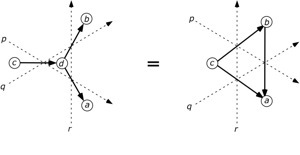Specific Heat
The specific heat of the two-dimensional Ising Model diverge logarithmically at the
critical temperature T
c .
The specific
heat-uniform.mw
is a maple program that plots the specific heat and spontaneous magnetization of the two dimensional
Ising model
with horizontal interaction energy J and vertical interaction J' with s=J'/J.
By utilizing this program, one can obtain the figure shown below, which is identical to the
figures in the aforementioned book,
The Two-Dimensional Ising Model.
Finite Strip
Due to the finite width of the strip, in this case the system is no longer two-dimensional, becoming
one-dimensional with a rounded peak.
A. Ferdinand and
M. E. Fisher in 1969 evaluated the specific heat for the Ising model on an infinite
long strip of width m with periodic boundary conditions imposed on the vertical and horizontal directions.
The integrand happens to be ill behaved at very low temperature. Nevertheless they managed with some
clever trick to evaluated a strip of width up to 64.
Here we include a program,
specific heat-finite.mw which
evaluated a strip of width 32, requiring a
computer with more than 8 gigbyte of memory. Below is a figure of the specific heat for
different m. Since it is a finite system, the specific heat is not divergent, but have a peak, which
approaches T
c as m approaches infinity.
Correlation Functions
This is the only non-trivial model in which correlation functions can be studied extensively.
It is found that these correlation functions satisfy difference equations.
Star-Triangle Equations and Z-invariance
The integrable models satisfy the Yang-Baxter equations, or the star-triangle equation, as shown below:

Consequently the dashed lines
r, which are called rapidity lines, can be moved from
left to right through vertices—the intersection of lines
p and
q.
In 1986,
Rodney Baxter
considered an integrable model on a planar but irregular lattice, thereby showing
that the correlations of the integrable model have many unusual properties. All such models, he called
Z-invariant.
↑ back to top ↑
Difference Equations
The Ising correlation functions also satisfy difference equations.
The Z-invariant property and the difference equations were used extensively in
the calculation of the susceptibility series coefficients for honeycomb and triangular lattices.
Moreover, it enabled us to calculate the q-dependent susceptibility on quasi-periodic lattices.
Please refer to the following talk for more information regarding difference equations of the Ising Model:
Please refer to the following talk for more information regarding difference equations of the
Ising Model:
Integrability in Statistical Mechanics
Jacques H. H. Perk
September 4, 2008
↑ back to top ↑
Series
The difference equations for the Ising correlation functions make it much easier to calculate the
coefficients of the susceptibility series. This transforms the difficulty of these calculations from
the usual exponential growth level to polynomial growth.
Included here are the low and high temperature susceptibility series (
series.mw)
for the square lattice. These coefficients are large integers. Therefore the pade2 written
by
Derksen,
there are links for other series. is most useful for its analysis. On the sites of
Tony Guttmann and
Iwan Jansen,
many long series are obtained and can be found.
↑ back to top ↑
Quasicrystals
These correlation functions of the Ising Model can be used to study quasicrystals.
Please refer to the following talk:
Diffraction
The Fraunhofer diffraction pattern for five pinholes arranged in a pentagon is shown in the following pictures.
The bright portions signify the highest intensities while the dark areas are for the low intensity.
This is governed by the following equation:

The magnetic susceptibility is very similar to the diffraction pattern, which can be measured experimentally.
Magnetic susceptibility can be calculated for the following quasi-periodic Ising lattice
 Two Ising lattices on Penrose tiles
Two Ising lattices on Penrose tiles
The spins on the odd sublattice (the first Ising model)
are joined by bonds, but the spins on the even sublattice (the second Ising model on the dual
lattice) are denoted by circles without their bonds. The two lattices are independent.
The coordination number, which is the number of adjacent spins connected to a given spin in each sublattice,
takes values 3, 4, 5, 6, or 7.
Pentagrid
The density plots of the susceptibility of the Z-invariant ferromagnetic Ising model are illustrated in the figures
below. As the temperature approaches critical temperature, so that the correlation length approaches infinity,
more and more peaks become visible, as shown by the following figures:
For more details see the following talks
The susceptibility of Quasi-periodic Ising Lattice
Helen Au-Yang
Shanghai Nov.8, 2008
Some Recent Results on Pair
Correlation Functions and Susceptibilities in Exactly Solvable Models
J.\ H.\ H.\ Perk
Dunk Island July 2005
↑ back to top ↑